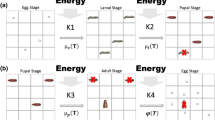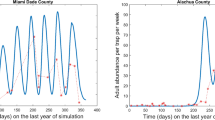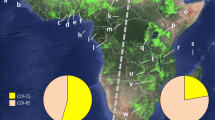Abstract
Fall armyworm, Spodoptera frugiperda (J.E. Smith), is a highly mobile insect pest of a wide range of host crops. However, this pest of tropical origin cannot survive extended periods of freezing temperature but must migrate northward each spring if it is to re-infest cropping areas in temperate regions. The northward limit of the winter-breeding region for North America extends to southern regions of Texas and Florida, but infestations are regularly reported as far north as Québec and Ontario provinces in Canada by the end of summer. Recent genetic analyses have characterized migratory pathways from these winter-breeding regions, but knowledge is lacking on the atmosphere’s role in influencing the timing, distance, and direction of migratory flights. The Hybrid Single-Particle Lagrangian Integrated Trajectory (HYSPLIT) model was used to simulate migratory flight of fall armyworm moths from distinct winter-breeding source areas. Model simulations identified regions of dominant immigration from the Florida and Texas source areas and overlapping immigrant populations in the Alabama–Georgia and Pennsylvania–Mid-Atlantic regions. This simulated migratory pattern corroborates a previous migratory map based on the distribution of fall armyworm haplotype profiles. We found a significant regression between the simulated first week of moth immigration and first week of moth capture (for locations which captured ≥10 moths), which on average indicated that the model simulated first immigration 2 weeks before first captures in pheromone traps. The results contribute to knowledge of fall armyworm population ecology on a continental scale and will aid in the prediction and interpretation of inter-annual variability of insect migration patterns including those in response to climatic change and adoption rates of transgenic cultivars.






Similar content being viewed by others
References
Blanco CA, Pellegaud JG, Nava-Camberos U, Lugo-Barrera D, Vega-Aquino P, Coello J, Téran-Vargas AP, Vargas-Camplis J (2014) Maize pests in Mexico and challenges for the adoption of integrated pest management programs. J Integr Pest Manag 5(4). doi:http://dx.doi.org/10.1603/IPM14006
Cannon RJC (1998) The implications of predicted climate change for insect pests in the UK, with emphasis on non-indigenous species. Glob Chang Biol 4:785–796
Chapman JW, Nesbit RL, Burgin LE, Reynolds DR, Smith AD, Middleton DR, Hill JK (2010) Flight orientation behaviors promote optimal migration trajectories in high-flying insects. Science 327:682–685
Chapman JW, Bell JR, Burgin LE, Reynolds DR, Pettersson LB, Hill JK, Bonsall MB, Thomas JA (2012) Seasonal migration to high latitudes results in major reproductive benefits in an insect. Proc Natl Acad Sci U S A 109:14924–14929
Drake VA, Gatehouse AG (eds) (1995) Insect migration: tracking resources through space and time. Cambridge University Press, Cambridge, 478 pp
Draxler RR (1999) HYSPLIT4 user's guide. NOAA Tech Memo ERL ARL-230. NOAA Air Resources Laboratory, Silver Spring
Draxler RR, Hess GD (1997) Description of the HYSPLIT_4 modeling system. NOAA Tech Memo ERL ARL-224. NOAA Air Resources Laboratory, Silver Spring, 24 pp
Draxler RR, Hess GD (1998) An overview of the HYSPLIT_4 modeling system of trajectories, dispersion, and deposition. Aust Meteorol Mag 47:295–308
Draxler RR, Rolph GD (2013) HYSPLIT (HYbrid single-particle Lagrangian integrated trajectory) model access via NOAA ARL READY Website (http://ready.arl.noaa.gov/HYSPLIT.php). NOAA Air Resources Laboratory, Silver Spring
Eagles D, Deveson T, Walker PJ, Zalucki MP, Durr P (2012) Evaluation of long-distance dispersal of Culicoides midges into northern Australia using a migration model. Med Vet Entomol 26:334–340
Feng HQ, Wu XF, Wu B, Wu KM (2009) Seasonal migration of Helicoverpa armigera (Lepidoptera: Noctuidae) over the Bohai Sea. J Econ Entomol 102:95–104
Feng H, Gould F, Huang Y, Jiang Y, Wu K (2010) Modeling the population dynamics of cotton bollworm Helicoverpa armigera (Hübner) (Lepidoptera: Noctuidae) over a wide area in northern China. Ecol Modelling 221:1819–1830
Fleischer SJ, Harding CL, Blom PE, White J, Grehan J (2005) Spodoptera frugiperda pheromone lures to avoid nontarget captures of Leucania phragmatidicola. J Econ Entomol 98:66–71
Fuxa JR (1987) Spodoptera frugiperda susceptibility to nuclear polyhedrosis virus isolates with reference to insect migration. Environ Entomol 16:218–223
Gregg PC, Del Socorro AP, Rochester WA (2001) Field test of a model of migration of moths (Lepidoptera: Noctuidae) in inland Australia. Aust J Entomol 40:249–256
Han W, Yang Z, Di L, Mueller R (2012) CropScape: A web service based application for exploring and disseminating US conterminous geospatial cropland data products for decision support. Comput Electron Agric 84:111–123
Han W, Yang Z, Di L, Yagci AL, Han S (2014) Making cropland data layer data accessible and actionable in GIS education. J Geogr. doi:10.1080/00221341.2013.838286
Hardke JT, Leonard BR, Huang F, Jackson RE (2011) Damage and survivorship of fall armyworm (Lepidoptera: Noctuidae) on transgenic field corn expressing Bacillus thuringiensis Cry proteins. Crop Prot 30:168–172
Hartstack AW Jr, Lopez JD Jr, Muller RA, Sterling WL, King EG, Witz JA, Eversull AC (1982) Evidence of long-range migration of Heliothis zea (Boddie) into Texas and Arkansas. Southwest Entomol 7:188–201
Hogg DB, Pitre HN, Anderson RE (1982) Assessment of early-season phenology of the fall armyworm (Lepidoptera, Noctuidae) in Mississippi. Environ Entomol 11:705–710
Kim KS, Jones GD, Westbrook JK, Sappington TW (2010) Multidisciplinary fingerprints: forensic reconstruction of an insect reinvasion. J R Soc Interface 7:677–686
Leskinen M, Markkula I, Koisinen J, Pylkkö P, Ooperi S, Siljamo P, Ojanen H, Raiskio S, Tiilikkala K (2011) Pest insect immigration warning by an atmospheric dispersion model, weather radars and traps. J Appl Entomol 135:55–67
Levy HC, Garcia-Maruniak A, Maruniak JE (2002) Strain identification of Spodoptera frugiperda (Lepidoptera: Noctuidae) insects and cell line: PCR-RFLP of Cytochrome Oxidase Subunit I gene. Fla Entomol 85:186–190
Lingren PD, Westbrook JK, Bryant VM, Raulston JR, Esquivel JF, Jones GD (1994) Origin of corn earworm (Lepidoptera, Noctuidae) migrants as determined by citrus pollen markers and synoptic weather systems. Environ Entomol 23:562–570
Lu YJ, Adang MJ (1996) Distinguishing fall armyworm (Lepidoptera: Noctuidae) strains using a diagnostic mitochondrial DNA marker. Fla Entomol 79:48–55
Luginbill P (1928) The fall armyworm. USDA Tech Bull 34:91
Meagher RL, Gallo-Meagher M (2003) Identifying host strains of fall armyworm (Lepidoptera: Noctuidae) in Florida using mitochondrial markers. Fla Entomol 86:450–455
Mitchell ER (1979) Migration by Spodoptera exigua and S. frugiperda, North America style. In: Rabb RL, Kennedy GG (eds) Movement of highly mobile insects: concepts and methodology in research. North Carolina State University, Raleigh, pp 386–393
Mitchell ER, McNeil JN, Westbrook JK, Silvain JF, Lalanne-Cassou B, Chalfant RB, Pair SD, Waddill VH, Sotomayor-Rios A, Proshold FI (1991) Seasonal periodicity of fall armyworm, (Lepidoptera:Noctuidae) in the Caribbean basin and northward to Canada. J Entomol Sci 26:39–50
Nagoshi RN, Meagher RL (2008) Review of fall armyworm (Lepidoptera: Noctuidae) genetic complexity and migration. Fla Entomol 91:546–554
Nagoshi RN, Silvie P, Meagher RL Jr (2007a) Comparison of haplotype frequencies differentiate fall armyworm (Lepidoptera: Noctuidae) corn-strain populations from Florida and Brazil. J Econ Entomol 100:954–961
Nagoshi RN, Silvie P, Meagher RL Jr, Lopez J, Machado V (2007b) Identification and comparison of fall armyworm (Lepidoptera: Noctuidae) host strains in Brazil, Texas, and Florida. Ann Entomol Soc Am 100:394–402
Nagoshi RN, Meagher RL, Flanders K, Gore J, Jackson R, Lopez J, Armstrong JS, Buntin GD, Sansone C, Leonard BR (2008) Using haplotypes to monitor the migration of fall armyworm (Lepidoptera: Noctuidae) corn-strain populations from Texas and Florida. J Econ Entomol 101:742–749
Nagoshi RN, Fleischer SJ, Meagher RL (2009) Texas is the overwintering source of fall armyworm in central Pennsylvania: implications for migration into the northeastern United States. Environ Entomol 38:1546–1554
Nagoshi RN, Meagher RL, Hay-Roe M (2012) Inferring the annual migration patterns of fall armyworm (Lepidoptera: Noctuidae) in the United States from mitochondrial haplotypes. Ecol Evol 2:1458–1467
Neild RE, Newman JE (1990) Growing season characteristics and requirements in the Corn Belt. National corn handbook NCH-40. Purdue University, West Lafayette
Pair SD, Westbrook JK (1995) Agroecological and climatological factors potentially influencing armyworm Lepidoptera, Noctuidae populations and their movement in the southeastern United States. Southwest Entomol Suppl 18:101–118
Pair SD, Raulston JR, Sparks AN, Westbrook JK, Douce GK (1986) Fall armyworm distribution and population dynamics in the southeastern states. Fla Entomol 69:468–487
Pashley DP (1986) Host-associated genetic differentiation in fall armyworm (Lepidoptera: Noctuidae): a sibling species complex? Ann Entomol Soc Am 79:898–904
Pashley DP (1988) Quantitative genetics, development, and physiological adaptation in host strains of fall armyworm. Evolution 42:93–102
Pashley DP, Johnson SJ, Sparks AN (1985) Genetic population structure of migratory moths: the fall armyworm (Lepidoptera: Noctuidae). Ann Entomol Soc Am 78:756–762
Pashley DP, Quisenberry SS, Jamjanya T (1987) Impact of fall armyworm (Lepidoptera: Noctuidae) host strains on the evaluation of bermudagrass resistance. J Econ Entomol 80:1127–1130
Pitre HN (1988) Relationship of fall armyworm (Lepidoptera:Noctuidae) from Florida, Honduras, Jamaica, and Mississippi: susceptibility to insecticides with reference to migration. Fla Entomol 71:56–61
Prowell DP, McMichael M, Silvain J-F (2004) Multilocus genetic analysis of host use, introgression, and speciation in host strains of fall armyworm (Lepidoptera: Noctuidae). Ann Entomol Soc Am 97:1034–1044
Raulston JR, Pair SD, Sparks AN, Loera J, Pedraza FA, Palamon A, Ortega A, Sanchez JR, Marquez P, Rueles H, Perez J, Rodriquez R, Carrillo H, Archundia R, Herrera F (1986) Fall armyworm distribution and population dynamics in the Texas-Mexico Gulf Coast area. Fla Entomol 69:455–468
Rochester WA, Dillon ML, Fitt GP, Zalucki MP (1996) A simulation model of the long-distance migration of Helicoverpa spp. moths. Ecol Model 86:151–156
Rolph GD (2013) Real-time environmental applications and display system (READY) website (http://ready.arl.noaa.gov). NOAA Air Resources Laboratory, Silver Spring
Rose AH, Silversides RH, Lindquist OH (1975) Migration flight by an aphid, Rhopalosiphum maidis (Hemiptera: Aphididae), and a noctuid, Spodoptera frugiperda (Lepidoptera: Noctuidae). Can Entomol 107:567–576
R Development Core Team (2008) R: a language and environment for statistical computing. R Foundation for Statistical Computing, Vienna, Austria (http://www.R-project.org)
Snow JW, Copeland WW (1969) Fall armyworm: use of virgin female traps to detect males and to determine seasonal distribution. USDA Prod Res Rep No 110, 9 p
Sparks AN (1979) A review of the biology of the fall armyworm. Fla Entomol 62:82–86
Stefanescu C, Páramo F, Åkesson S, Alarcón M, Ávila A, Brereton T, Carnicer J, Cassar LF, Fox R, Heliölä J, Hill JK, Hirneisen N, Kjellén N, Kühn E, Kuussaari M, Leskinen M, Liechti F, Musche M, Regan EC, Reynolds DR, Roy DB, Ryrholm N, Schmaljohann H, Settele J, Thomas CD, van Swaay C, Chapman JW (2012) Multi-generational long-distance migration of insects: studying the painted lady butterfly in the Western Palaearctic. Ecography 35:001–014
Wang YQ (2014) MeteoInfo: GIS software for meteorological data visualization and analysis. Meteorol Appl 21:360–368
Westbrook JK (2008) Noctuid migration in Texas within the nocturnal aeroecological boundary layer. Integr Comp Biol 48:99–106
Westbrook JK, Lopez J (2010) Long distance migration in Helicoverpa zea: what we know and need to know. Southwest Entomol 35:355–360
Westbrook JK, Sparks AN (1986) The role of atmospheric transport in the economic fall armyworm (Lepidoptera: Noctuidae) infestations in the southeastern United States in 1977. Fla Entomol 69:494–502
Westbrook JK, Eyster RS, Wolf WW, Lingren PD, Raulston JR (1995) Migration pathways of corn earworm (Lepidoptera: Noctuidae) indicated by tetroon trajectories. Agric For Meteorol 73:67–87
Westbrook JK, Wolf WW, Lingren PD, Raulston JR, Lopez JD, Matis JH, Eyster RS, Esquivel JF, Schleider PG (1997) Early-season migratory flights of corn earworm (Lepidoptera: Noctuidae). Environ Entomol 26:12–20
Westbrook JK, Esquivel JF, López JD Jr, Jones GD, Wolf WW, Raulston JR (1998) Validation of bollworm migration across south-central Texas in 1994-96. Southwest Entomol 23:209–219
Westbrook JK, Eyster RS, Allen CT (2011) A model for long-distance dispersal of boll weevils (Coleoptera: Curculionidae). Int J Biometeorol 55:585–593
Wolf WW, Westbrook JK, Raulston JR, Pair SD, Lingren PD (1995) Radar observations of orientation of noctuids migrating from corn fields in the Lower Rio Grande Valley. Southwest Entomol Suppl 18:45–61
Young JR (1979) Fall armyworm: control with insecticides. Fla Entomol 62:130–133
Acknowledgments
T. M. O’Neil, T. Sappington, B. R. Leonard, K. Estes, J. Obermeyer, G. Lorenz, B. McCornack, K. Tindall, A. Michel, T. Baute, P. Porter, J. S. Armstrong, E. Burkness, D. Cook, F. Musser, J. Knodel, J. Bradshaw, R. Wright, T. Hunt, T. Royer, R. Parker, A. Knutson, H. Stevens, E. Cullen, F. Peairs, J. Whalen, S. Menasha, J. Ingerson-Mahar, K. Holmstrom, T. Kuhar, A. Herbert, G. Dively, A. Muza, J. Timer, R. Pollack, T. Ford, R. Troyer, K. Watrous, A. Bachmann, C. Sidhu, C. Loveland, T. Abbey, T. Elkner, E. Swackhammer, and T. Bailey assisted in trapping moths and reporting weekly moth capture data. This work was supported by the National Institute of Food and Agriculture, U.S. Department of Agriculture, under Agreement No. 2011-67003-30209. USDC-NOAA provided access to HYSPLIT PC version 4.9 atmospheric transport modeling software. Mention of trade names or commercial products in this article is solely for the purposes of providing specific information and does not imply recommendation or endorsement by the U.S. Department of Agriculture. USDA is an equal opportunity provider and employer.
Author information
Authors and Affiliations
Corresponding author
Rights and permissions
About this article
Cite this article
Westbrook, J.K., Nagoshi, R.N., Meagher, R.L. et al. Modeling seasonal migration of fall armyworm moths. Int J Biometeorol 60, 255–267 (2016). https://doi.org/10.1007/s00484-015-1022-x
Received:
Revised:
Accepted:
Published:
Issue Date:
DOI: https://doi.org/10.1007/s00484-015-1022-x




